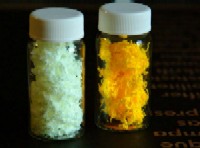|
|
||
Amanda Holt is currently working on biosensors. A biosensor is a device in which a biological element is used to sense chemicals in a system. The goal of the biosensor device is to produce an electric signal that is proportional to the amount of a chemical or a set of chemicals being sensed. Biosensors thus have an interdisciplinary design, combining the sensitivity and specificity of biological systems with the computational abilities of microprocessors. Biosensors are utilized in many fields such as medicine where they may be useful in diagnosing medical conditions and detecting genetic disorders, environmental monitoring of pollution and detection of hazardous chemicals, and in food analysis. The current commercial market of biosensors is dominated by the hand-held, one-shot amperometric glucose monitors, which are used by diabetics to monitor and thus control glucose levels. This enables more effective prevention of diabetic complications such as blindness, kidney and heart failure and gangrene. Also, similar hand held devices are being used to detect pesticides and pollutants in air and water. The success of biosensor research has paved the way for these commercial portable sensors but there is still a need for further research on long lasting, real time implantable, noninvasive monitors and monitors that simultaneously measure more than one element. This is why organic conjugated polymers have attracted much interest in this field. They can be used to enhance the speed, versatility and sensitivity of a biosensor lending to possibilities for real-time noninvasive biosensors and multi-arrayed biosensors for detecting multiple chemicals. There are many different ways that organic conjugated polymers can “sense” something. In particular, I am working on understanding optical biosensors in which the reaction of the polymer to the presence of the anylate is optical. If a photoluminescent polymer is used then its luminescence can be quenched and unquenched relative to a given analyate, signaling the presence of that chemical (For more information on this type of optical biosensor see Chen et al.). This type of biosensor has already been used to analyze amounts of avidin in solution and I am interested in studying the quenching effects on different types of photoluminescent polymers as well as expanding the types of anylates that can be sensed. Research articles of interest: Heeger, P. and Alan Heeger. “Making Sense of Polymer-Based Biosensors.” PNAS. 96 (1999): 12219 – 12221. Chen, Liaohai, et al. “Highly Sensitive Biological and Chemical Sensors Based on Reversible Fluorescence Quenching in a Conjugated Polymer.” PNAS 96 (1999): 12287-12292.
|
||
|
|
